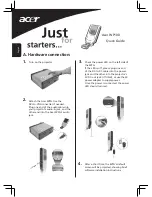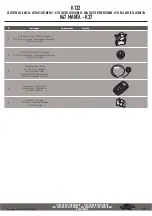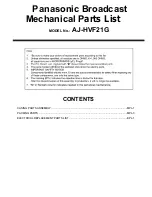
Functionality of the backup camera
If the vehicle is placed in reverse while it is running, the backup lights come on. Since the
backup camera is connected to one of the backup lights, the camera thus also switches on at
the same time.
Only the area to the back that is recorded by the camera appears on your monitor. The overlaid
coloured lines are used to evaluate the distance to obstacles.
The image of the camera is shown mirrored, so that you see the image in the backup
monitor like the image in the rearview mirror.
If light falls directly on the camera, the surroundings may not be shown clearly. In
fl
uorescent light, the picture may
fl
icker.
Colours of the surroundings that are shown on the monitor - especially in darkness -
can deviate from the actual colours of the surroundings.
Wireless devices such as WLAN devices, Bluetooth devices or mobile communica-
tion devices can have a disruptive in
fl
uence on the operation of the monitor. If this is
the case, you will see rolling lines, blurry images or static images on the monitor.
Maintenance and care
Check the camera’s technical safety at regular intervals, e.g. for damage to the connection
cables and to the camera itself.
If it can be assumed that safe operation is no longer possible, the product must be turned off
and precautions are to be taken to ensure that it is not used unintentionally. Disconnect the
camera!
Safe operation can no longer be assumed if:
• the camera shows visible damage
• the camera no longer functions, or
• following considerable mechanical stress
Check the functionality at regular intervals.
Clean the camera regularly. To do this, do not use devices that spray water, such as steam jets,
or chemical cleaning agents; these can attack or damage the material of the housing.
Disposal
Electronic devices are recyclable waste materials and must not be disposed of in the
household waste!
Dispose of an unserviceable product in accordance with the relevant statutory regu-
lations.
Technical data
Operating voltage: ........................12 V/DC
Current consumption: ...................100 mA
Detection angle: ............................105° hor./75° vert.
Resolution: ....................................648 x 488
TV System: ...................................PAL
Video output: ................................1 Vpp/75 ohms
Mounting hole: ..............................18.8 mm
Dimensions: ..................................20.5 x 20.5 mm (Ø x L)
Weight: .........................................45 g
Operating temperature range: ......-20 °C to +70 °C at max. 95% rel. humidity
These operating instructions are a publication by Conrad Electronic SE, Klaus-Conrad-Str. 1,
D-92240 Hirschau (www.conrad.com).
All rights including translation reserved. Reproduction by any method, e.g. photocopy, micro
fi
lming,
or the capture in electronic data processing systems require the prior written approval by the editor.
Reprinting, also in part, is prohibited.
These operating instructions represent the technical status at the time of printing. Changes in
technology and equipment reserved.
© Copyright 2013 by Conrad Electronic SE.
The upper side of the camera is marked. This label must point upward so that later
the camera image is not displayed upside down.
• Carefully place the connection cable inside so that no moisture can get into the inside of the
car. Use the provided rubber grommets at the points where the cable passes into the car’s
interior, and if needed, use additional suitable sealing compound.
Electrical Connection and First Use
The electrical connection may be done only by a specialist.
To avoid shorts and any resulting damage to the camera and the vehicle, the
negative terminal (earth) of the car battery has to be disconnected during the
connection. Only re-connect the negative pole of the battery when the system
is fully connected and after you have checked the connection.
Follow the instructions from the vehicle’s manufacturer to ensure that none of
the vehicle’s saved data (time, radio stations, etc.) is lost.
Only use a voltmeter or a diode test lamp to check the voltage of the vehicle
system leads, as normal test lamps consume excessive voltage and may thus
damage the vehicle’s electronics.
Adhesive techniques which become ever more common and painted metal
parts impair the electric conductivity. Therefore not every metal part is a suit-
able earthing point.
When laying the cables, make sure that they are not squeezed or abraded on
sharp edges. Use rubber grommets for the lead-though points.
When laying cables in door frames, etc., make sure that no safety-related
equipment (such as side airbags) is affected. The cables may not be laid
within range of the fully-expanded airbag.
1
2
3
4
5
6
• Connect the mini-plug connector (1) to the camera with the adapter cable (2).
• Insert the plug of the power supply cable (5) into the red connection (3) on the adapter cable
(2).
• Plug one of the yellow video plugs of the video cable (6) to the yellow video jack (4) on the
adapter cable (2).
• Connect the other yellow plug of the video cable (6) to the video input of your backup monitor.
• Connect the power supply cable (5) to a backup light of your vehicle. To do this, connect the
red wire with the positive cable to the backup light and the black wire to a suitable earthing
point or an earthing wire.
Because the camera should only be activated when the car is in reverse, the power
supply is created through the backup light.
To identify the positive cable to the backup light and the earthing cable, either con-
sult the circuit diagram of your vehicle or measure the voltage directly at the backup
light with a voltmeter when the car is in reverse and the ignition is switched on. For
this purpose, naturally, the minus pole of the battery must
fi
rst be reconnected.
• After the connection work has been completed, reconnect the minus pole of the battery and
put the car in reverse while the ignition is switched on.
• The backup monitor should now display the image received from the backup camera. It may
be that you will need to activate the corresponding video input of the backup monitor manu-
ally for this purpose.


























